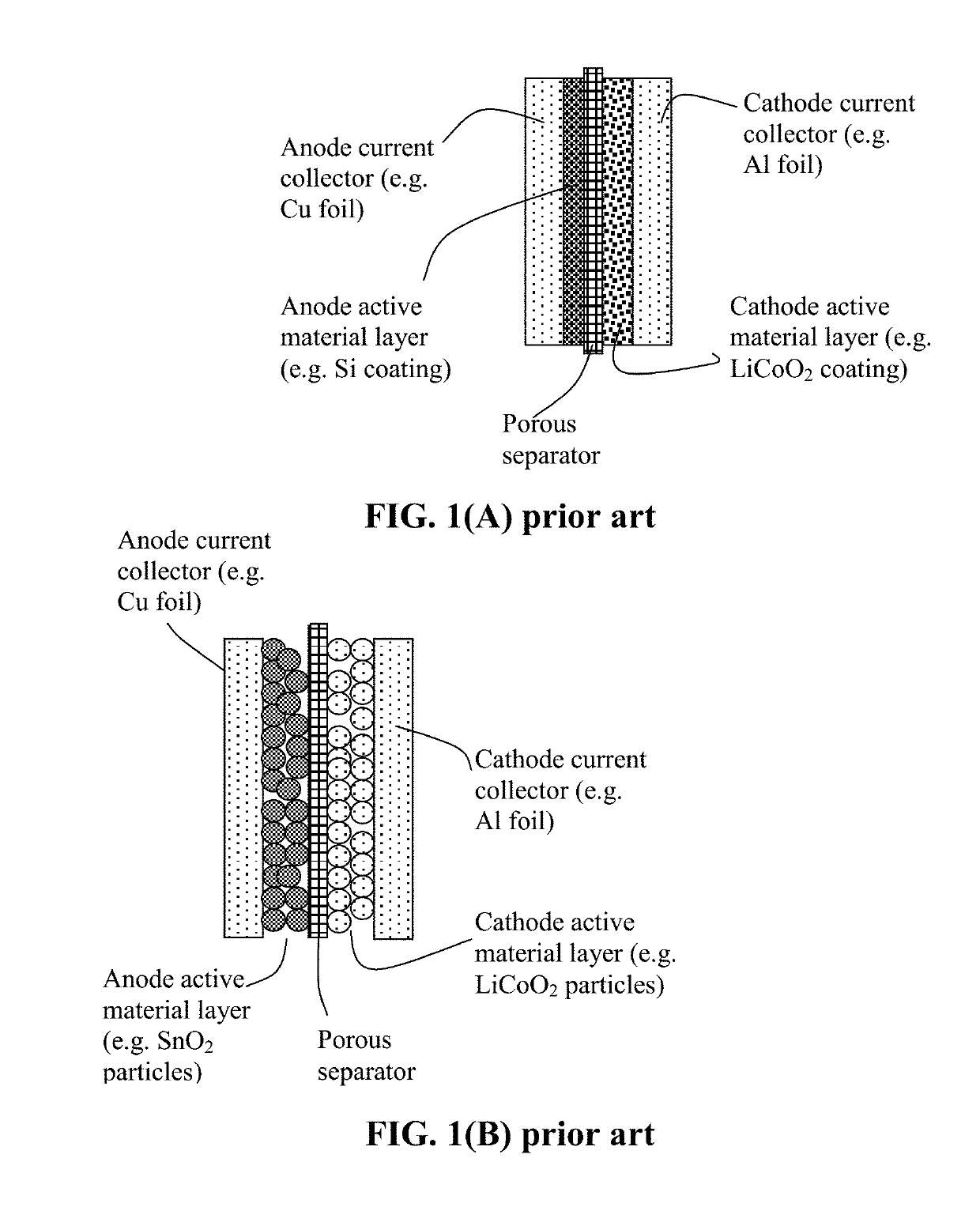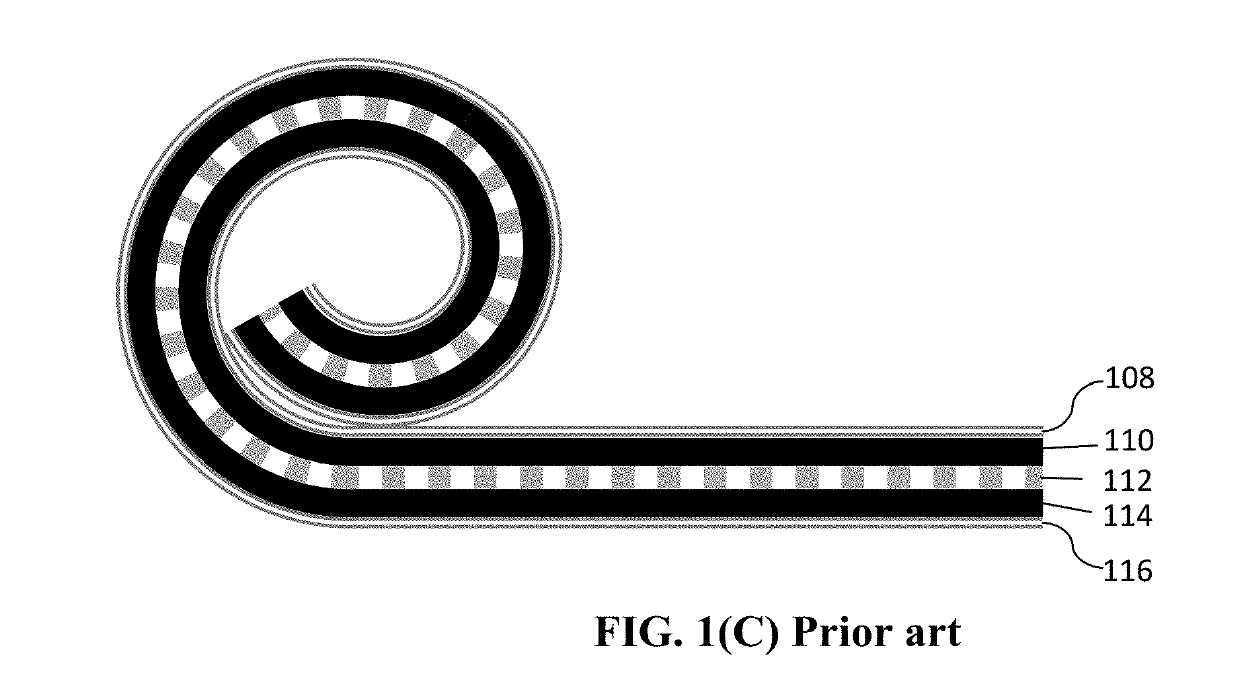Method of Producing Participate Electrode Materials for Alkali Metal Batteries
a technology of metal batteries and participate electrodes, which is applied in the field of alkali batteries, can solve the problems of high cost of lithium, short circuiting in the internal cavity, and the potential of significantly lower cost of na batteries
- Summary
- Abstract
- Description
- Claims
- Application Information
AI Technical Summary
Benefits of technology
Problems solved by technology
Method used
Image
Examples
example 1
ticulates of Si Nanoparticles, Carbon Nanofibers (CNFs), and Lithium Salt
[0157]First, Si nanoparticles and CNFs at a weight ratio of 95:5 were dispersed in an organic liquid electrolyte, containing 1.0 M of LiPF6 dissolved in PC-EC, to form a slurry. Then, 0.2% by wt. of poly(ethylene oxide) (PEO) was added into the slurry to form a gel-like mass, which was diluted by adding some acetonitrile (AN) to the extent that the overall solid content was approximately 10% by weight. The resulting slurry was spray-dried to remove AN and form anode particulates that were approximately 15-32 μm in diameter.
Example 2: Anode Particulates of Cobalt Oxide (Co3O4)-CNT-Lithium Salt
[0158]An appropriate amount of inorganic salts Co(NO3)2.6H2O and ammonia solution (NH3.H2O, 25 wt. %) were mixed together. The resulting suspension was stirred for several hours under an argon flow to ensure a complete reaction. The obtained Co(OH)2 precursor suspension was calcined at 450° C. in air for 2 h to form particl...
example 4
on of Graphene Oxide (GO) and Reduced Graphene Oxide (RGO) Nanosheets (as a Preferred Conductive Material) from Natural Graphite Powder
[0164]Natural graphite was used as the starting material. GO was obtained by following the well-known modified Hummers method, which involved two oxidation stages. In a typical procedure, the first oxidation was achieved in the following conditions: 1100 mg of graphite was placed in a 1000 mL boiling flask. Then, 20 g of K2S2O8, 20 g of P2O5, and 400 mL of a concentrated aqueous solution of H2SO4 (96%) were added in the flask. The mixture was heated under reflux for 6 hours and then let without disturbing for 20 hours at room temperature. Oxidized graphite was filtered and rinsed with abundant distilled water until neutral pH. A wet cake-like material was recovered at the end of this first oxidation.
[0165]For the second oxidation process, the previously collected wet cake was placed in a boiling flask that contains 69 mL of a concentrated aqueous sol...
example 5
on of Pristine Graphene Sheets (0% Oxygen)
[0168]Recognizing the possibility of the high defect population in GO sheets acting to reduce the conductivity of individual graphene plane, we decided to study if the use of pristine graphene sheets (non-oxidized and oxygen-free, non-halogenated and halogen-free, etc.) can lead to a conductive additive (or a discrete conductive material layer) having a high electrical and thermal conductivity. Prelithiated pristine graphene and pre-sodiated pristine graphene were also used as an anode active material for a lithium-ion battery and a sodium-ion battery, respectively. Pristine graphene sheets were produced by using the direct ultrasonication or liquid-phase production process.
[0169]In a typical procedure, five grams of graphite flakes, ground to approximately 20 μm or less in sizes, were dispersed in 1,000 mL of deionized water (containing 0.1% by weight of a dispersing agent, Zonyl® FSO from DuPont) to obtain a suspension. An ultrasonic energ...
PUM
 Login to View More
Login to View More Abstract
Description
Claims
Application Information
 Login to View More
Login to View More - R&D
- Intellectual Property
- Life Sciences
- Materials
- Tech Scout
- Unparalleled Data Quality
- Higher Quality Content
- 60% Fewer Hallucinations
Browse by: Latest US Patents, China's latest patents, Technical Efficacy Thesaurus, Application Domain, Technology Topic, Popular Technical Reports.
© 2025 PatSnap. All rights reserved.Legal|Privacy policy|Modern Slavery Act Transparency Statement|Sitemap|About US| Contact US: help@patsnap.com



